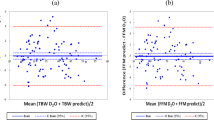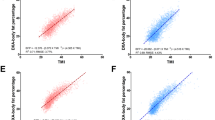Abstract
Objective: To develop new equations for the estimation of basal metabolic rate in children aged 10–15 years, and to evaluate the impact of including pubertal stage into the equations.
Design: Mixed longitudinal.
Setting: The children were recruited from schools in Oxford, and the measurements were made in the schools.
Subjects: 195 school children, aged 10–15 years, were recruited in three cohorts. The gender distribution of the subjects was 40% boys and 60% girls.
Methods: Basal metabolic rate (BMR) was measured, by indirect calorimetry, at 6-monthly intervals for 3 years. Anthropometric data, height, weight, body breadths and skinfold measurements (biceps, triceps, subscapular, suprailiac and medial calf) were collected on each occasion. Fat and fat-free mass was calculated from the skinfold measurements. Pubertal development was also assessed on annually by paediatricians. Pubic hair (PH) and gonad (G) development was assessed in boys and breast (B) development in girls. The girls were questioned about menarche. Stepwise multiple regression analysis was used to develop and assess new formulae for BMR that also incorporate pubertal development.
Results: The mean BMR measured was 5.754 (s.d. 0.933) MJ/day (138 (s.d. 22) kJ/kg body wt/day) in the boys (n=351) and 5.476 (s.d. 0.725) MJ/day (121 (s.d. 20) kJ/kg body wt/day) in the girls (n=554). Weight was the most important factor in developing the regression equations for the calculation of BMR in both sexes (R2=0.61 and 0.52 for boys and girls, respectively). Stepwise multiple regression analyses, with independent variables such as gender, weight, height, puberty stage and skinfolds, allowed several BMR regression equations to be developed. The inclusion of the menarche status in the regression equations significantly (P<0.05) improved BMR estimation in the pre-menarche girls. Boys, pubertal stage as assessed by Pubic Hair (PH) and Gonadal Stage (G) did not contribute to a significant improvement in BMR estimation, except for 11-year-olds.
Conclusions: The inclusion of pubertal stage afforded only minor improvements in the derivation of regression equations for the estimation of BMR of children aged between 10 and 15 years.
Sponsorship: Nestlé Foundation, Lausanne, Switzerland.
Descriptors:
This is a preview of subscription content, access via your institution
Access options
Subscribe to this journal
Receive 12 print issues and online access
$259.00 per year
only $21.58 per issue
Buy this article
- Purchase on Springer Link
- Instant access to full article PDF
Prices may be subject to local taxes which are calculated during checkout
Similar content being viewed by others
Author information
Authors and Affiliations
Rights and permissions
About this article
Cite this article
Henry, C., Dyer, S. & Ghusain-Choueiri, A. New equations to estimate basal metabolic rate in children aged 10–15 years. Eur J Clin Nutr 53, 134–142 (1999). https://doi.org/10.1038/sj.ejcn.1600690
Received:
Revised:
Accepted:
Published:
Issue Date:
DOI: https://doi.org/10.1038/sj.ejcn.1600690
Keywords
This article is cited by
-
Dietary intakes assessed by 24-h recalls in peri-urban African adolescents: validity of energy intake compared with estimated energy expenditure
European Journal of Clinical Nutrition (2011)
-
Determinants of resting energy expenditure in obese and non-obese children and adolescents
Journal of Physiology and Biochemistry (2002)



